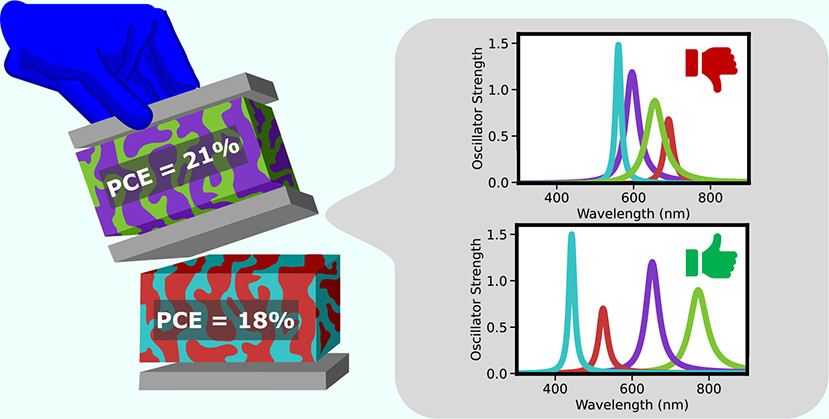Screening Efficient Tandem Organic Solar Cells with Machine Learning and Genetic Algorithms
Brianna L. Greenstein, Geoffrey R. Hutchison. “Screening Efficient Tandem Organic Solar Cells with Machine Learning and Genetic Algorithms” J. Phys. Chem. C 2023, 127, 13, 6179–6191 Online
 Tandem organic solar cells can potentially drastically improve the power conversion efficiency over single-junction devices. However, there is limited research on device development and often ca. 1% improvement over single-junction devices. Because of the complex nature of organic material compatibility and properties, such as energy-level alignment and maximizing absorption spectra, and the vastness of chemical space, computational guidance is vital. The first part of this work uses a new data set of 1225 donor/non-fullerene acceptor (NFA) pairs containing 1001 unique pairs, one of the largest to date, to train an ensemble machine learning model to predict device efficiency (RMSE = 1.60 ± 0.14%). Next, a series of genetic algorithms (GAs) are used to discover high-performing NFAs and polymer donors and then combinations of them for potential high-efficiency tandem cells. Interesting design motifs show up in high-performing NFAs, such as diphenylamine substituents on the core and 3D terminal groups. The donor polymers from the GAs reveal that arranging the monomers as a small-block copolymer may be beneficial instead of the typical alternating copolymer. The GAs for selecting tandem cell materials successfully find material combinations that, when in a device together, have strong absorption across the entire visible–near-IR spectrum. Computational guidance is critical for the selection of tandem OSC materials, with genetic algorithms proving a highly successful technique.
Tandem organic solar cells can potentially drastically improve the power conversion efficiency over single-junction devices. However, there is limited research on device development and often ca. 1% improvement over single-junction devices. Because of the complex nature of organic material compatibility and properties, such as energy-level alignment and maximizing absorption spectra, and the vastness of chemical space, computational guidance is vital. The first part of this work uses a new data set of 1225 donor/non-fullerene acceptor (NFA) pairs containing 1001 unique pairs, one of the largest to date, to train an ensemble machine learning model to predict device efficiency (RMSE = 1.60 ± 0.14%). Next, a series of genetic algorithms (GAs) are used to discover high-performing NFAs and polymer donors and then combinations of them for potential high-efficiency tandem cells. Interesting design motifs show up in high-performing NFAs, such as diphenylamine substituents on the core and 3D terminal groups. The donor polymers from the GAs reveal that arranging the monomers as a small-block copolymer may be beneficial instead of the typical alternating copolymer. The GAs for selecting tandem cell materials successfully find material combinations that, when in a device together, have strong absorption across the entire visible–near-IR spectrum. Computational guidance is critical for the selection of tandem OSC materials, with genetic algorithms proving a highly successful technique.